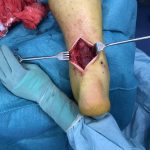Nationwide implementation of anterior cruciate ligament injury prevention – Why is so hard to get it done?
Editor
Jesper Møller Rimestad1.2
1: Danish Center for Healthcare Improvements, Institut for Økonomi og Ledelse, Aalborg Universitet
2: Center for Almen Medicin, Klinisk Institut, Aalborg Universitet
Kontakt adresse: jmr@business.aau.dk
Background
Sports-related anterior cruciate ligament (ACL) rupture is a severe knee injury occurring primarily in young people involved in organised sports [1]. In Denmark, approximately 2500 ACL reconstructions are performed annually, with the incidence peaking in the 15-24-year-olds and soccer is the most common activity at the time of injury [2]. However, this does not reflect the actual incidence of ACL injuries as the amount of non-surgically treated injuries are unknown. The short-term consequences of ACL rupture include reconstructive surgery (if so chosen), lengthy rehabilitation, and absence from sports and reduced quality of life [3,4]. Even with reconstruction, many individuals do not return to their preinjury level, or they cannot return to sports – resulting in a physically inactive lifestyle [3] – and there is a high risk for a second ACL injury [5]. ACL injury represents a significant economic burden at the time of injury in terms of rehabilitative and surgical costs and results in several indirect costs, e.g. productivity loss, absence from education, and physical inactivity, with the latter being associated with adverse weight gain and obesity in adolescence [6,7]. Also, physical inactivity increases the risk of chronic disease and increased mortality rate in later life [8]
ACL injury during adolescence leading to osteoarthritis in early adulthood
At long-term follow-up, irrespective of whether ACL reconstruction is performed or not, ACL injuries increase the risk of early-onset knee osteoarthritis (OA), especially with a combined meniscal injury. The prevalence of knee OA after an ACL injury significantly increased with time [9,10]. A systematic review and meta-analysis by Ajuied et al. [11], reported a relative risk of 3.84 for developing signs of moderate to severe OA changes at around ten years post ACL injury when compared with uninjured contralateral knees.
As a consequence of the early development of knee OA, a recent study found the odds of a total knee replacement (TKR) later in life is nearly seven times larger in those with previous ACL injury compared to no ACL injury [12]. Additionally, those who underwent TKR after previous ACL injury were significantly younger (mean age, 55 years) at time of TKR than those without a previous ACL injury (mean age, 70 years) [12]. As OA is a chronic condition, resulting in pain, functional impairment, and reduced quality of life in middle age [13], knee OA secondarily to ACL injury carries a substantial economic burden to society [14]. In Denmark, the total social costs associated with OA for 2010 was DKK 6.8 billion, of which, health care utilisation was by far the most considerable part, DKK 5.4 billion, while short-term and long-term productivity losses amounted to DKK 0.6 and 0.8 billion, respectively [15]. However, with ACL injury being a modifiable risk factor for developing OA, injury prevention programs may lead to preventing or delaying the development of OA.
Injury prevention through exercise-based programmes
Multiple meta-analyses over the last decade have demonstrated that ACL injuries are preventable through neuromuscular training warm-up programmes. A recent meta-analysis, combining all previous meta-analyses into one, found an overall 50% reduction of ACL injuries in all athletes and a 67% reduction for non-contact ACL injuries in females [16]. Similarly, a recent meta-analysis investigated the exercise-based football injury prevention programme ‘11+’, and reported a 39% reduction of overall football injuries and a 48% reduction of knee injuries [17].
Recent research has investigated dissemination and implementation strategies of injury prevention programs [18] as well as barriers to implementation and suggested ways to minimise the barriers [19,20]. Common barriers to compliance with injury prevention programs include motivation, skill requirements, and perceived time constraints. A survey of 101 coaches’ knowledge, usage, and barriers of injury prevention programs in youth soccer, by Mawson et al. [19], found that over 80% of the coaches were not using an injury prevention program, though they would consider using one knowing that it may reduce a player’s risk of injury by 45%. Additionally, 74% would consider using a program if it took 20 minutes or less and could be used as warm up. Thus, coach education and coaching courses should emphasise the efficacy of injury prevention programs and change the perceived time constraints [19]. Including the ‘11+’ and ‘11+ Kids’ in coaches’ education could enable a countrywide reach as well through nationwide campaigns, e.g. as started in New Zealand (Fit4football). However, even though, interventions as ‘11+’ and ‘11+ Kids’ are readily available online at no cost, some cost is probably associated with the process of implementing a national preventions program, and with tight budgets and scares resources, the potential costs for preventive programs may present a barrier.
Cost-effectiveness of injury prevention programmes
Comparing implementation strategies for a national universal ACL injury prevention programme in Australia, Lewis et al. [21] found a prevention programme to be a cost-effective strategy compared with no injury prevention programme, with better outcomes and lower costs in high-intensity sports in young people. Due to reductions of ACL injuries, reinjures, and subsequent development of OA and the need for TKA, they, found an annual saving of US$53 per participant of direct health costs, by introducing a prevention program to adolescents and young adults aged 12–25 who participate in high-risk ACL injury sports [21]. A recent similar Danish study (by Rimestad et al. in review) investigating the cost-effectiveness of a national ACL injury prevention programme for youth in Denmark, found a significant reduction of ACL injuries and in so averting the higher risk of developing of knee OA. Thus, finding a Danish sports injury prevention programme (e.g. the FIFA 11+ and FIFA 11+ KIDS) for youth to be a cost-effective strategy compared to the current practice.
Even though both studies found potential significant cost savings, by introducing a prevention program, they included only the preventive effect of ACL injuries. A cost-effectiveness analysis alongside a cluster RCT found a 38% reduction in injury risk with neuromuscular training compared with a standard warm-up, resulting in healthcare costs being reduced by 43% [22]. A similar cost-effectiveness analysis found using the ‘11+ Kids’ injury prevention programme as a warm-up in 7-12-year-old children, to reduce the number of injuries by 50% compared with a usual warmup, thereby reducing the healthcare costs by 51% [23]. The results from these studies, the annual societal cost savings by reducing sports injuries, could represent a potential expenditure for an injury prevention programme.
Where to go from here
Considering both the aforementioned conclusive evidence that ACL injuries are preventable, as well as ACL injuries having a dramatic effect on the cumulative lifetime incidence of knee OA and the need for TKR, and the societal cost savings (both on short and long term) provides a convincing case for a national implementation of an injury prevention programme. Effective warm-up programs to prevent non-contact ACL injuries that are ready to be used without significant investment or being time demanding do already exist. These findings provide essential information for policy makers and stakeholders to prioritise programs for injury prevention among adolescents and young adults at risk of a knee injury. A national strategy to prevent ACL injuries is highly likely to provide significant societal benefit, improving health outcomes while simultaneously reducing medical costs, due to the reduction in both sports injuries and subsequent rates of knee OA. Due to the fact, that different stakeholders stand to gain from implementing an injury prevention programme at different time points, raises the question of who should initially invest in a prevention program? There is a need for intervention planning to identify potential barriers and create workable solutions at different stakeholder level, as different dissemination and implementation strategies may be needed to maximize the efficacy of an injury prevention program at different levels. Such encounters should include input from policymakers and stakeholders, which could include politicians, the Danish Football Association, the clubs, coaches, and the parents in youth sport.
Reference
1 Gornitzky AL, Lott A, Yellin JL, et al. Sport-Specific Yearly Risk and Incidence of Anterior Cruciate Ligament Tears in High School Athletes. Am J Sports Med 2016;44:2716–23. doi:10.1177/0363546515617742
2 Prentice HA, Lind M, Mouton C, et al. Patient demographic and surgical characteristics in anterior cruciate ligament reconstruction: a description of registries from six countries. Br J Sports Med 2018;52:716–22. doi:10.1136/bjsports-2017-098674
3 Ardern CL, Taylor NF, Feller JA, et al. Fifty-five per cent return to competitive sport following anterior cruciate ligament reconstruction surgery: An updated systematic review and meta-analysis including aspects of physical functioning and contextual factors. Br J Sports Med 2014;48:1543–52. doi:10.1136/bjsports-2013-093398
4 Kvist J, Kartus J, Karlsson J, et al. Results From the Swedish National Anterior Cruciate Ligament Register. Arthrosc J Arthrosc Relat Surg 2014;30:803–10. doi:10.1016/j.arthro.2014.02.036
5 Wiggins AJ, Grandhi RK, Schneider DK, et al. Risk of Secondary Injury in Younger Athletes After Anterior Cruciate Ligament Reconstruction. Am J Sports Med 2016;44:1861–76. doi:10.1177/0363546515621554
6 Myer GD, Faigenbaum AD, Foss KB, et al. Injury initiates unfavourable weight gain and obesity markers in youth. Br J Sports Med 2014;48:1477–81. doi:10.1136/bjsports-2012-091988
7 Whittaker JL, Woodhouse LJ, Nettel-Aguirre A, et al. Outcomes associated with early post-traumatic osteoarthritis and other negative health consequences 3–10 years following knee joint injury in youth sport. Osteoarthr Cartil 2015;23:1122–9. doi:10.1016/j.joca.2015.02.021
8 Ekelund U, Steene-Johannessen J, Brown WJ, et al. Does physical activity attenuate, or even eliminate, the detrimental association of sitting time with mortality? A harmonised meta-analysis of data from more than 1 million men and women. Lancet 2016;388:1302–10. doi:10.1016/S0140-6736(16)30370-1
9 Øiestad BE, Engebretsen L, Storheim K, et al. Winner of the 2008 Systematic Review Competition: Knee Osteoarthritis after Anterior Cruciate Ligament Injury. Am J Sports Med 2009;37:1434–43. doi:10.1177/0363546509338827
10 Cinque ME, Dornan GJ, Chahla J, et al. High Rates of Osteoarthritis Develop After Anterior Cruciate Ligament Surgery: An Analysis of 4108 Patients. Am J Sports Med 2018;46:2011–9. doi:10.1177/0363546517730072
11 Ajuied A, Wong F, Smith C, et al. Anterior cruciate ligament injury and radiologic progression of knee osteoarthritis: A systematic review and meta-analysis. Am J Sports Med. 2014;42:2242–52. doi:10.1177/0363546513508376
12 Khan T, Alvand A, Prieto-Alhambra D, et al. ACL and meniscal injuries increase the risk of primary total knee replacement for osteoarthritis: a matched case–control study using the Clinical Practice Research Datalink (CPRD). Br J Sports Med 2018;:bjsports-2017-097762. doi:10.1136/bjsports-2017-097762
13 Lohmander LS, Englund PM, Dahl LL, et al. The Long-term Consequence of Anterior Cruciate Ligament and Meniscus Injuries. Am J Sports Med 2007;35:1756–69. doi:10.1177/0363546507307396
14 Hunter DJ, Schofield D, Callander E. The individual and socioeconomic impact of osteoarthritis. Nat Rev Rheumatol 2014;10:437–41. doi:10.1038/nrrheum.2014.44
15 Johnson NF, Koch MB, Davidsen M, et al. De samfundsmæssige omkostninger ved artrose. Statens Institut for Folkesundhed, SDU 2014. http://www.si-folkesundhed.dk/Udgivelser/Bøger og rapporter/2014/Artrose.aspx
16 Webster KE, Hewett TE. Meta-analysis of meta-analyses of anterior cruciate ligament injury reduction training programs. J Orthop Res 2018;36:2696–708. doi:10.1002/jor.24043
17 Thorborg K, Krommes KK, Esteve E, et al. Effect of specific exercise-based football injury prevention programmes on the overall injury rate in football: a systematic review and meta-analysis of the FIFA 11 and 11+ programmes. Br J Sports Med 2017;51:562–71. doi:10.1136/bjsports-2016-097066
18 DiStefano LJ, Frank BS, Root HJ, et al. Dissemination and Implementation Strategies of Lower Extremity Preventive Training Programs in Youth: A Clinical Review. Sport Heal A Multidiscip Approach 2017;9:524–31. doi:10.1177/1941738117731732
19 Mawson R, Creech MJ, Peterson DC, et al. Lower limb injury prevention programs in youth soccer: a survey of coach knowledge, usage, and barriers. J Exp Orthop 2018;5:43. doi:10.1186/s40634-018-0160-6
20 Bogardus RL, Martin RJ, Richman AR, et al. Applying the Socio-Ecological Model to barriers to implementation of ACL injury prevention programs: A systematic review. J Sport Heal Sci 2019;8:8–16. doi:10.1016/j.jshs.2017.11.001
21 Vertullo CJ, Comans TA, Kirkbride B, et al. Comparison of four alternative national universal anterior cruciate ligament injury prevention programme implementation strategies to reduce secondary future medical costs. Br J Sports Med 2016;52:277–82. doi:10.1136/bjsports-2016-096667
22 Marshall DA, Lopatina E, Lacny S, et al. Economic impact study: neuromuscular training reduces the burden of injuries and costs compared to standard warm-up in youth soccer. Br J Sports Med 2016;50:1388–93. doi:10.1136/bjsports-2015-095666
23 Rössler R, Verhagen E, Rommers N, et al. Comparison of the ‘11+ Kids’ injury prevention programme and a regular warmup in children’s football (soccer): a cost effectiveness analysis. Br J Sports Med 2019;53:309–14. doi:10.1136/bjsports-2018-099395





